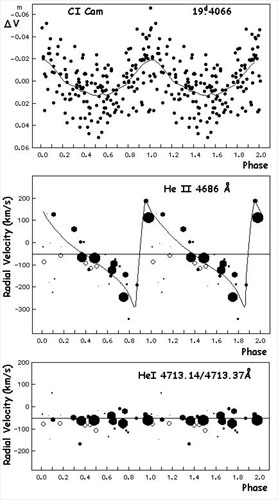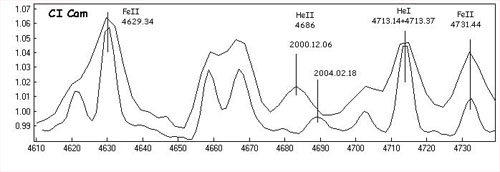

Figure 1. The light curve of CI Cam in
residuals relative to the mean level of the slow
variability (top). The radial velocity curve
of the HeII emission (middle). The velocity curve
of the nearby close HeI doublet (bottom).
The curves were build versus phase of 19.4 day period.
To probe the low-amplitude light variability, we have
taken dense 28 day long sets of photoelectric and CCD data
of CI Cam in November and December 2002.
New observations did not confirm small amplitude
11.7 day variations first noted by A.S.Miroshnichenko
AsAp. Trans. V.6, 251 (1995). But these observations
demonstrate a wave with the longer period, 19.4 days.
On the base of our photometry taken in the time range 1998-2005
in quiescence (172 nights, average values), one may improve
its value to 19.41+/-0.02 days. The V light curve is
shown in Figure 1 (top). The procedures of reduction
these ununiform data to a single system
and elimination of slow trend were performed to present this curve.
Periodic composition of the light curve has amplitude
of 0m.032. The ephemeris is the following
Max =JD hel. 2452200.75 +19d.407*E.
The majority of lines in the spectrum of CI Cam do not
show noticeable variability of radial velocity in the
quiet state. FeII emissions forming in the stellar wind
have rectangular profile of 1.2A width, and centroid
radial velocity -51 km/s. This velocity does not vary
in our spectra. However we noted that very faint
HeII 4686A line (EW~0.3A) changes its position relative
to nearby lines by more than 400 km/s (see Fig.2). We measured
radial velocities and found that these changes depend on the
phase of 19.4 day period (Fig. 1, middle). Sometimes the line
looks very faint, and vanishes in the noise of spectrum.
So, the quality of its profile was estimated visually
in tenfold scale. If the profile is bell-shaped and strong
enough, the quality was 10. On the contrary, if it looks like
a weak fluctuation on the noise level, the value was 1.
Non symmetric or noise distorted profiles estimated by
intermediate values depending on degree of distortion.
The radii of black circles in the Figure 1 (middle) agree with
these estimates, and depend on the quality of the spectrum.
Open circles mark the observations made during the outburst.
Let us note that the intensity of HeII emission increased in
the peak of the outburst by 300 times.

Figure 2. Comparison of two CI Cam spectra in the
region of HeII line. The maximum displacement of HeII line
profile due to Doppler effect is seen. Two FeII lines
are marked to be a reference points to improve the accuracy
of velocities, and HeI doublet is chosen to check the
accuracy.
The radial velocity curve of HeII in CI Cam has a saw-tooth
shape that may be an evidence of an elliptical
orbit. Half-amplitude Kx~230 km/s. The
best-fit model drawn in the Figure 1 (middle) implies the orbit
eccentricity close to 0.62. The orbit major semiaxis
a*sin( i ) ~ 42 million km. At the inferior
conjunction, the source of emission is located near
periastron, and light maximum occurs later with the
shift of 0.06 P. The moment of inferior conjunction may be
dated by JD 2452199.6+/-0.2, although the observations are
absent in this phase. Based on our spectra, the primary
companion of CI Cam system is a B4 III-V star with the
expected value of mass being no more than 7 solar masses,
and of radius being no more than 6 solar radii. Mass
function of HeII emission source is 12 solar masses. This
value is a lower limit of the primary star mass, and this
is almost twice more than expected one for normal star of such
type. The radial velocity
semi-amplitude of this star is imperceptibly small (less
than 10 km/s). Then the mass of the HeII emission source
star in this limiting case may be less than 0.5 solar
masses. Very likely, the fast moving companion is a white
dwarf, and the emission source is an accretion disk around it.
Download Table of Vr
View the collection of row UBV(RjRc) photometry of CI Cam.
Needs a Java compatible brouser.
Use mouse function mouseDrag to examine the details.
Download row photometric data (VBURj/Rc).
Paper to VAC-2004 conference in Moscow on CI Cam.
Home page.